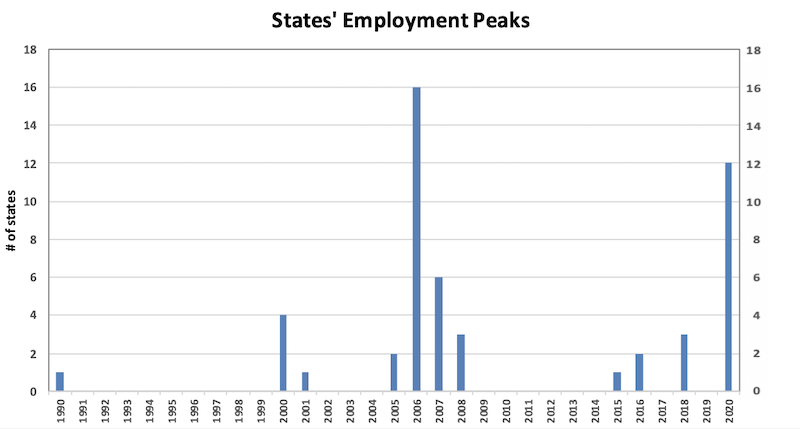Only eight states and the District of Columbia have recouped the severe pandemic-induced losses of construction jobs that occurred last spring, according to an analysis by the Associated General Contractors of America of government employment data released today. Association officials warned that job losses will become even more widespread unless lawmakers promptly renew and expand the loan program that enabled firms to temporarily retain and rehire many workers.
“New spikes in coronavirus cases, along with ongoing pandemic-related costs and revenue losses, are causing ever more private owners, developers, and public agencies to delay and cancel projects,” said Ken Simonson, the association’s chief economist. “Although single-family homebuilding is gathering steam, multifamily and nonresidential construction activity has stalled, leaving large numbers of workers at risk of losing their jobs as current projects finish up with nothing on the horizon.”
Seasonally adjusted construction employment in September was lower than in February—the last month before the pandemic forced many contractors to suspend work—in 42 states, Simonson added. California lost the most construction jobs over that span (-54,900 jobs, -6.1%), followed by Texas (51,800 jobs, -6.5%). Vermont had the largest percentage loss (-24.5%, -3,600 jobs), followed by Iowa (-14.6%, -11,400 jobs).
Of the eight states added construction jobs from February to September, Virginia added the most (4,300 jobs, 2.1%), followed by Utah (3,800 jobs, 3.3%). South Dakota posted the largest percentage gain (9.4%, 2,300 jobs), followed by Utah.
Construction employment decreased from August to September in 17 states, increased in 32 states, and was unchanged in Arkansas and D.C. Illinois shed the most construction jobs from August to September (-3,000 jobs or -1.4%), followed by Oregon (-2,600 jobs, -2.4%) and Iowa (-2,500 jobs, -3.6%). Iowa had the largest percentage decrease, followed by Oregon and New Mexico (-2.0%, -1,000 jobs).
New York added the most construction jobs over the month (5,300 jobs, 1.5%), followed by Louisiana (5,000 jobs, 4.1%) and Washington (4,200 jobs, 2.0%). Vermont had the largest percentage gain for the month (500 jobs, 4.7%), followed by Louisiana and New Hampshire (800 jobs, 3.0%).
Association officials warned that project cancellations are on the rise as new outbreaks of coronavirus across many states force many private owners and public officials to postpone or cancel planned starts. Association officials noted that the rapid adoption of Paycheck Protection Program loans last spring had enabled construction to bounce back quickly from the first round of project shutdowns and delays, and they urged lawmakers in Washington to act swiftly to extend and expand the program.
“The loans that were issued last spring saved tens of thousands of construction workers from unemployment but those funds are rapidly running out,” said Stephen E. Sandherr, the association’s chief executive officer. “Renewal of the loan program should be a top priority for any policy maker who cares about keeping the economy from backsliding.”
View state employment February-September data and rankings; August-September rankings; Highs and Lows.
Related Stories
Industry Research | Oct 25, 2016
New HOK/CoreNet Global report explores impact of coworking on corporate real rstate
“Although coworking space makes up less than one percent of the world’s office space, it represents an important workforce trend and highlights the strong desire of today’s employees to have workplace choices, community and flexibility,” says Kay Sargent, Director of WorkPlace at HOK.
Market Data | Oct 24, 2016
New construction starts in 2017 to increase 5% to $713 billion
Dodge Outlook Report predicts moderate growth for most project types – single family housing, commercial and institutional building, and public works, while multifamily housing levels off and electric utilities/gas plants decline.
High-rise Construction | Oct 21, 2016
The world’s 100 tallest buildings: Which architects have designed the most?
Two firms stand well above the others when it comes to the number of tall buildings they have designed.
Market Data | Oct 19, 2016
Architecture Billings Index slips consecutive months for first time since 2012
“This recent backslide should act as a warning signal,” said AIA Chief Economist, Kermit Baker.
Market Data | Oct 11, 2016
Building design revenue topped $28 billion in 2015
Growing profitability at architecture firms has led to reinvestment and expansion
Market Data | Oct 4, 2016
Nonresidential spending slips in August
Public sector spending is declining faster than the private sector.
Industry Research | Oct 3, 2016
Structure Tone survey shows cost is still a major barrier to building green
Climate change, resilience and wellness are also growing concerns.
Industry Research | Sep 27, 2016
Sterling Risk Sentiment Index indicates risk exposure perception remains stable in construction industry
Nearly half (45%) of those polled say election year uncertainty has a negative effect on risk perception in the construction market.
Market Data | Sep 22, 2016
Architecture Billings Index slips, overall outlook remains positive
Business conditions are slumping in the Northeast.
Market Data | Sep 20, 2016
Backlog skyrockets for largest firms during second quarter, but falls to 8.5 months overall
While a handful of commercial construction segments continue to be associated with expanding volumes, for the most part, the average contractor is no longer getting busier, says ABC Chief Economist Anirban Basu.

















